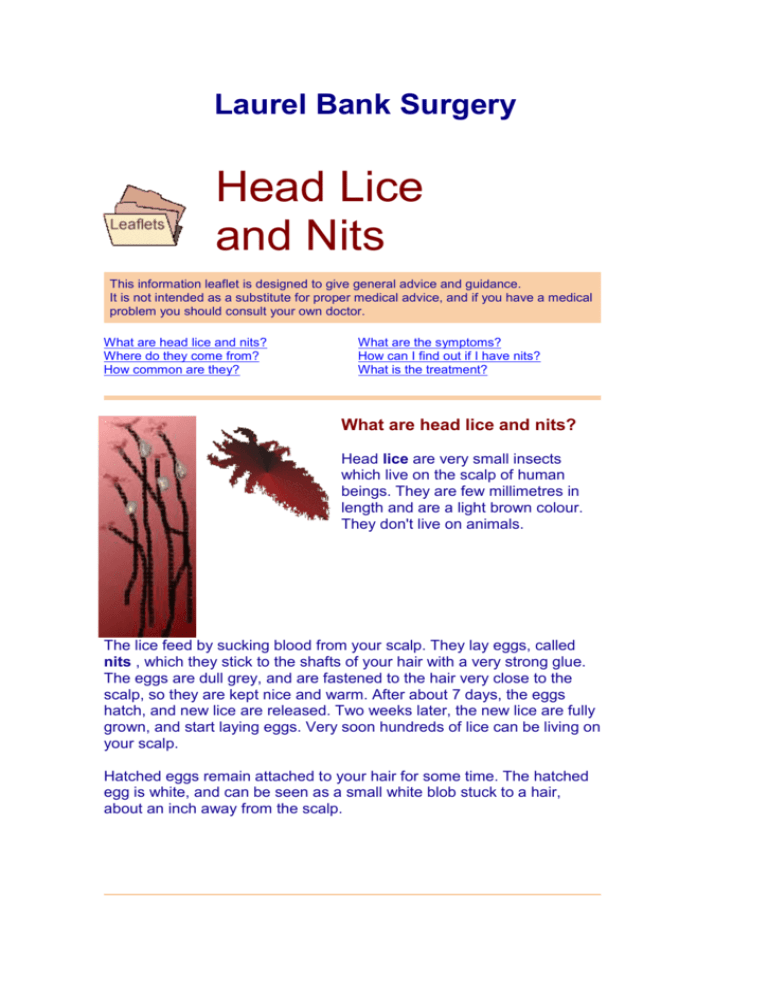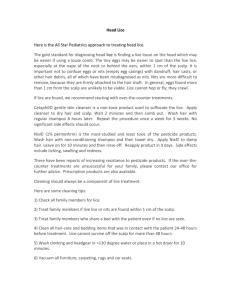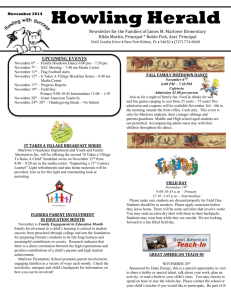Head_Lice - Laurel Bank Surgery
advertisement

Laurel Bank Surgery Head Lice and Nits This information leaflet is designed to give general advice and guidance. It is not intended as a substitute for proper medical advice, and if you have a medical problem you should consult your own doctor. What are head lice and nits? Where do they come from? How common are they? What are the symptoms? How can I find out if I have nits? What is the treatment? What are head lice and nits? Head lice are very small insects which live on the scalp of human beings. They are few millimetres in length and are a light brown colour. They don't live on animals. The lice feed by sucking blood from your scalp. They lay eggs, called nits , which they stick to the shafts of your hair with a very strong glue. The eggs are dull grey, and are fastened to the hair very close to the scalp, so they are kept nice and warm. After about 7 days, the eggs hatch, and new lice are released. Two weeks later, the new lice are fully grown, and start laying eggs. Very soon hundreds of lice can be living on your scalp. Hatched eggs remain attached to your hair for some time. The hatched egg is white, and can be seen as a small white blob stuck to a hair, about an inch away from the scalp. Where do they come from? Head lice can't jump or fly. They walk from one head to another. You catch head lice by having your head alongside the head of someone else who is infected with head lice. Once you are infected, you can pass head lice to any close friend, or family member, whose head is in contact with your head. Head lice die if they are not kept warm. It is very unusual for lice to be found on hats, scarves, brushes or combs. They don't survive on pillows or towels. Really, the only way of catching them is to be in head to head contact with an infected person. How common are they? Head lice are very common. In primary schools in the UK, probably one child in ten is infected every year. Young children tend to put their heads together, with friends or other family members, and lice are easily spread from person to person. This problem has got worse recently, and head lice are much more common then they used to be. Lice can live on long hair, short hair, dirty hair and on very clean hair. What are the symptoms? The main symptom of head lice is terrible itching of the scalp. Children are more bothered with itching then adults. Infected children will scratch their heads vigorously, and will often scratch during their sleep. Some infected adults hardly itch at all. The lice are small, dull brown in colour, and move very quickly. It is very hard to see them and almost impossible to catch them. How can I find out if I have nits? Here are three ways of finding out if you have head lice. 1. By using very fine tooth comb you may be able to comb dead lice and nits out of your hair. You can buy a special nit comb from the pharmacy. If you comb your hair over a piece of white paper, any nits or lice will be easier to spot. 2. A better way to find head lice is to comb your hair while it is wet. You will need to use a special nit comb. Wash your hair in the usual way and apply plenty of hair conditioner. Comb your hair while still wet and before you wash the conditioner off. Keep checking the comb for lice. The conditioner makes your hair slippery, and the lice find it hard to escape from the comb. 3. Another way to check your hair for lice is to look for the old eggs (or nits). The hatched nit eggs can be seen fairly easily. You will need to get someone else to check your hair for you. The nits are very small (smaller than a pin head), white in colour, and will be firmly stuck to the hairs, about an inch or two away from the scalp. They can be mistaken for dandruff, but you can't brush them away because they are firmly stuck to the hair. What is the treatment? There are two ways to get rid of head lice. 1. Using chemicals You can buy a variety of lice killing lotions or shampoos from the pharmacist. However, we strongly recommend you use the wetcombing method instead of using these chemical lotions. Some common treatments used in the UK are Derbac-M, Prioderm, Quellada-M, Sulleo-M, Lyclear and Full Marks. Ask the pharmacist for advice if you need treatment for o o o young babies (under 6 months) pregnant women people with asthma and always read the instructions carefully. Unfortunately, these chemicals don't always work. Lice can become resistant to these treatments. The repeated use of these chemicals may be harmful to our health. 2. "Wet combing" method This method is very safe. It is cheap, and works well. All you need is a large bottle of hair conditioner, a nit comb, and some time and patience. (It is best to ask someone to help you.) 1. Wash you hair with your usual shampoo 2. While your hair is wet, apply plenty of hair conditioner 3. Comb your hair using a fine nit comb. comb from the roots upwards check the comb for lice, and clear them away, after each sweep comb all your hair, a little at a time, carefully, 4. Repeat this every 3 days for 2 weeks to get rid of any newly hatched lice. Remember to check everyone in the family for lice and nits, using the methods described above . With a little time and effort, you can get rid of lice, safely, cheaply, and without using any chemicals.




